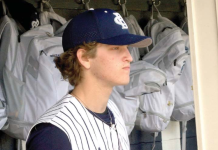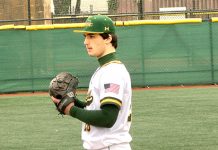By Ryan Fennell

Shrewsbury – Nearly every sport has made modifications to its game to allow young children to learn and enjoy its sport allowing for more natural development and achievement of some level of success.
Imagine a five-year-old kid standing at the plate with a 32-inch, 28-ounce bat waiting for a pitch from 60-feet away. Now imagine that five-year-old child miraculously makes contact with the ball and the other five-year-olds in the field have to try to make the out on a regulation baseball diamond.
Very few would want to show up for the next game.
Until recently, that is what the sport of tennis was asking of its youth – to play with regulation equipment on regulation-sized courts. Very few were having much success.
In 2008, the United States Tennis Association (USTA) launched its QuickStart program designed to allow younger children to begin playing tennis by learning proper technique, developing necessary skills, and having fun while doing it.
In September 2011, the New Shrewsbury Racquet Club in Shrewsbury implemented the QuickStart program and is now in full swing with 82 of the clubs 400 youth members between the ages of four and nine.
QuickStart is a modification of traditional tennis allowing children as young as three to begin learning the game.
“Unlike other sports where they modified the playing field, tennis never did that,” said New Shrewsbury Racquet Club Managing Partner Bob Sullivan. “It was harder for kids to have success at those younger ages.”
The QuickStart program uses smaller courts, smaller nets, and different types of tennis balls as a means of making it easier for the kids to start participating in activities that enable them to learn the sport at a younger age, while having fun, Sullivan said.
“It’s been a system that has opened up the door.”
The youngest age group uses a larger diameter “sponge” ball that travels slower through the air and is easier for children as young as three to return over the net.

The next stage is an orange/yellow ball that is 50-percent less the compression of a regulation tennis ball but is the same diameter and is used between the ages of seven and nine. The next stage is a green/yellow ball (not pictured) that is 75-percent less compressed than a regular tennis ball and is used by the USTA 10 and under tennis tournaments.
Sullivan and his coaches at the racquet club are excited about the modifications because it has attracted more children to the sport and has allowed them to continue learning the game whereas, prior to this approach, tennis as a sport was losing these youngsters to other sports.
According to Sullivan the use of the modified tennis balls not only allows the children to have fun while learning proper technique but also removes some of the fear involved when using the regulation equipment.
The modified tennis balls travel at lower speeds allowing the kids to use the right grips on the racquets, see the spin on the balls, and development of hand-eye coordination at a faster rate, while removing the fear of being struck by a highly-compressed tennis ball.
“We can get the kids technically doing things at a much quicker rate because it slows down the speed of the game,” Sullivan said.
The New Shrewsbury Racquet Club offers a one-hour QuickStart class once per week for 18 weeks.
“We keep the ratio 4-1, “ Sullivan said. “The kids are learning without even realizing that they’re learning in certain drills. Hopefully, we’re introducing a sport to kids at such a young age that they may become lifelong tennis players.”
“The biggest thing is they can hit it,” said the club’s QuickStart organizer Todd Peyton. “They can make the ball go over the net. Now they enjoy it.
“They’re actually producing a full swing with the lighter ball,” he added. “It actually really resembles more what they should be doing and they’re having so much fun.”
Before the QuickStart program kids were expected to learn the game with the regulation equipment on full-sized courts, and while some were able to get the ball over the net from the baseline, many of them were developing poor habits and poor muscle memory by ignoring proper technique, in order to simply get the ball across, Sullivan said.
“This would lead to poor technique and bad muscle memory leading to a plateau (in development) and eventually burn out,” Sullivan said.
While the early indication is that the QuickStart program is a step forward for youth tennis and tennis as a whole in the United States, there was some apprehension about implementing the program.
Since the sport of tennis is steeped in tradition, changing the way it was taught and the way young people learned to play was not an easy obstacle to overcome.
There had been some misgivings about children getting involved in the sport at an early age because of the high risk of burnout. While other organizations had made attempts at modifying the sport to cater to younger ages, it took a long time for the USTA to adopt and support them.

There was also the perception that changing the rules for younger players might have an adverse result for children that were already adept at the game. However, since the USTA requires that children under the age of 10 use the 75-percent less compressed ball in tournaments, the argument that anyone learning the sport using the QuickStart program would be at a disadvantage was quickly put to rest.
“Their skills are improving at a lightning fast rate compared to in the past,” said George Scholtz, an instructor at the club. “This is combining fun, skills, and physicality.
“To me, its going in leaps and bounds if these guys take up the sport when we get to the green ball because they’ve been exposed to it at a level where they’ve succeeded,” he added. “Frustration comes from a lack of success.”
Scholtz said that the program is allowing the children to develop the skills of physicality, technique, tactics, and coachabilty, which are all essential for success in any sport.
“I can’t tell you how much fun it’s been for us,” Peyton added. “It’s really rejuvenated some of us (as coaches). It’s been an absolute pleasure.”














